|
One Dollar | Two Dollar | Five Dollar | Ten Dollar | Twenty Dollar | Fifty Dollar | Hundred Dollar | Miscellaneous
|
Miscellaneous Currency |
|
Bank of America, Rhode Island One Dollar note
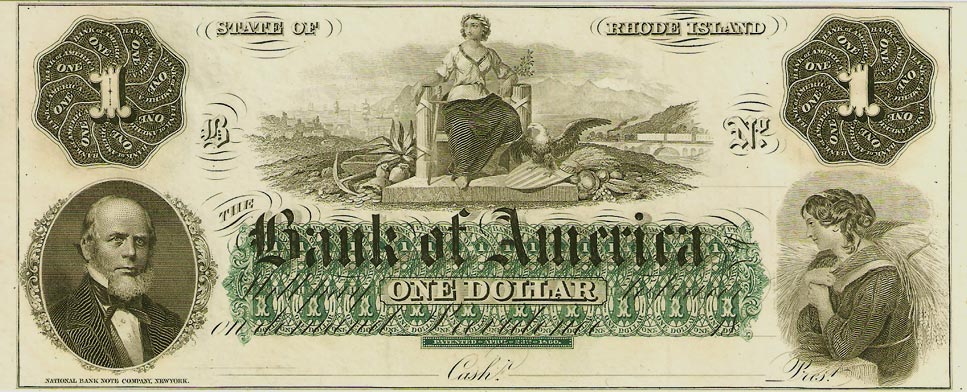
 
This $1.00 note was printed for the Bank of America of Providence, Rhode Island, by the National Bank Note Co. of New York. This "Bank of America" existed from 1851-90, after which it was absorbed by the Bank of America Loan & Trust Co. Notes such as these are commonly referred to as "Obsolete Currency" and were issued by state chartered banks and state and local governments up to the Civil War. This particular note, however, was never actually issued, which is why there is no serial number or signature.
The obverse of this note features a depiction of top center with a portrait of Adnah Sackett, the first president of this bank until he died in 1860, in the lower left. The obverse is completely blank.
|
|
Series 1969A One Dollar Federal Reserve Note [Error]

This $1.00 Federal Reserve Note is a particularly nice (and dark) example of "Offset Printing" or "Offset Transfer" error, which occurs when an inked plate makes contact with the bed, leading to no sheet being fed to the press to accept the intended ink. As a result, when the next sheet passes through the press, the area impressed onto the impression cylinder is then pressed onto the opposite side of the note. In general, this type of error can range from minor to a complete offset (as seen here), with the latter being more desirable to collectors.
|
|
Series 1988A One Dollar Federal Reserve Note [Error]
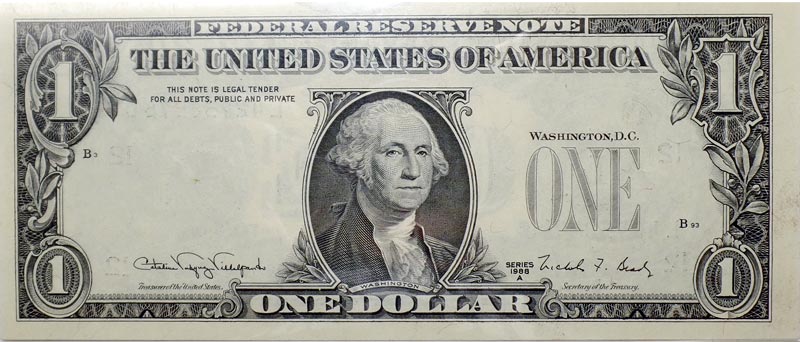
 
This $1.00 Federal Reserve Note would be unremarkable except for the fact that the Bureau of Engraving and Printing had some problems when printing it. This particular error, called "Overprint on Back" or "Reverse Overprint" is generally caused by an uncut sheet being fed into a press with the obverse of the note facing the overprinting press. The information printed by the overprinting press include Treasury and Federal Reserve District seals, district numbers and serial numbers. Such a note will be missing these elements from the front, and instead have each displayed on the back.
|
|
Series 1993 One Dollar Federal Reserve Note [Error]
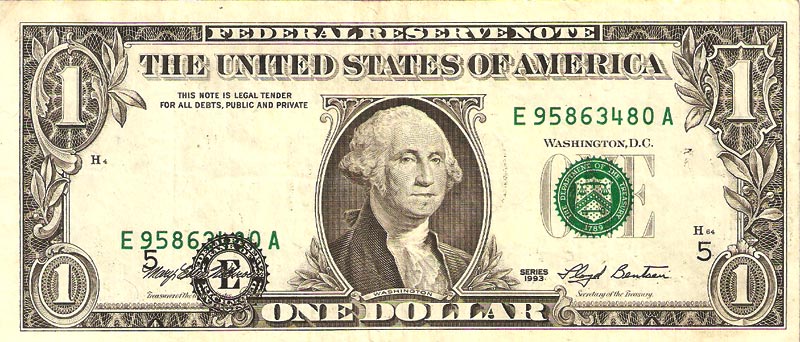
This $1.00 Federal Reserve Note is another example of a case where the Bureau of Engraving and Printing had some problems when printing it. This particular error, called "Seal Drop," occurs when the the currency sheet moves during the third printing when multiple elements are supposed to printed simultaneously (but are actually applied by different machines), causing some of the elements (in this case the black seal and the district numbers) to be shifted down.
|
|
Series 1985 One Dollar Federal Reserve Note [Fancy Serial Number]
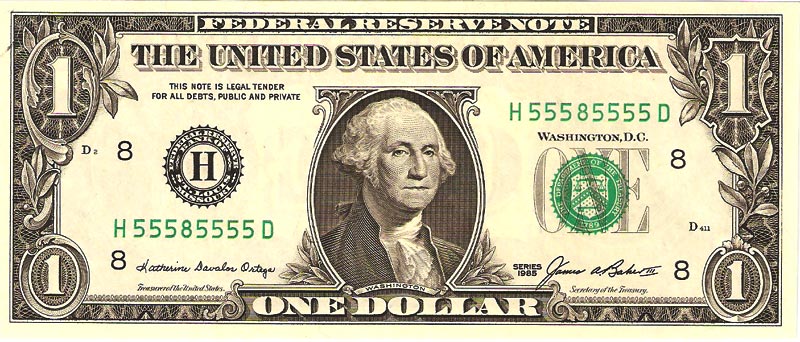
Nothing rare or particularly unusual about this Series 1985 One Dollar Federal Reserve Note, except for the fact that it has an unusual serial number of 55585555. This type of serial number is, I believe, referred to as a "Near Solid". If only that one 8 were a 5 instead...
|
|
One Dollar Federal Reserve Notes [Error]
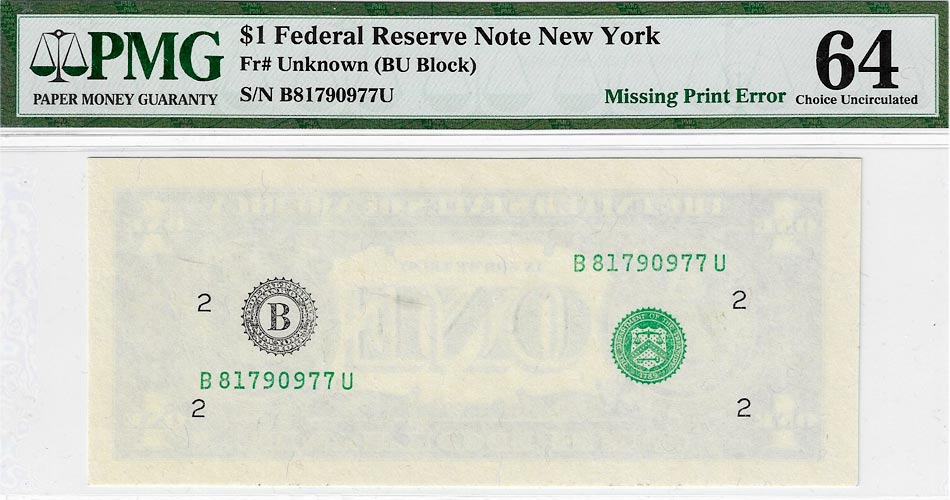

These sequential $1.00 Federal Reserve Notes are particularly nice examples of a "Missing 2nd Printing" error. When the second printing is missed (for whatever reason), the note will be missing its face printing, which includes the denomination, subject and series information. As a result, there's no way to tell what year these were printed.
|
|
Series 1981 Five Dollar Federal Reserve Note [Fancy Serial Number]
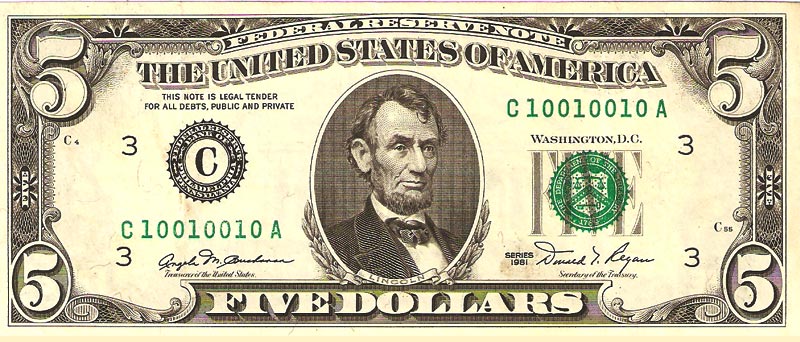
Nothing rare or particularly unusual about this Series 1981 Five Dollar Federal Reserve Note, except for the fact that it has an unusual serial number of 10010010. This type of serial number is, I believe, referred to as a "Binary".
|
|
Series 1969A Twenty Dollar Federal Reserve Note [Error]
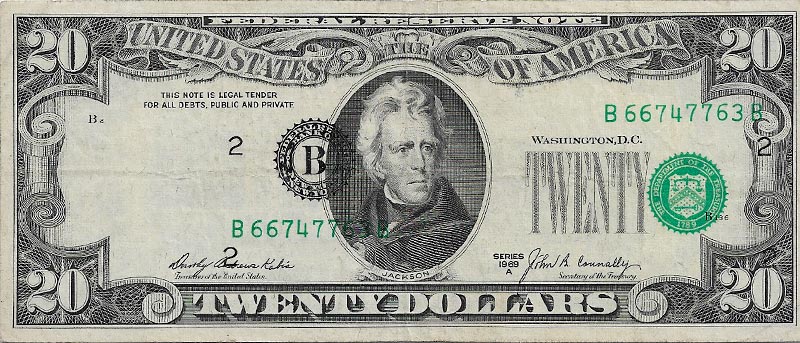
This $20.00 Federal Reserve Note is an example of a "Misaligned Overprint" error (a.k.a. Shifted 3rd Print), where a misalignment during the 3rd printing causes the serial numbers and seals to be out of position, vertically or horizontally, and so far from their appropriate position that they cover unintended portions of the note.
|
|
Series 1990 Twenty Dollar Federal Reserve Note [Error]

 
This $20.00 Federal Reserve Note is another example of an "Overprint on Back" or "Reverse Overprint" error, which is generally caused by an uncut sheet being fed into a press with the obverse of the note facing the overprinting press. The information printed by the overprinting press include Treasury and Federal Reserve District seals, district numbers and serial numbers. Such a note will be missing these elements from the front, and instead have each displayed on the back.
|
|
Series 2013 Twenty Dollar Federal Reserve Note [Error]
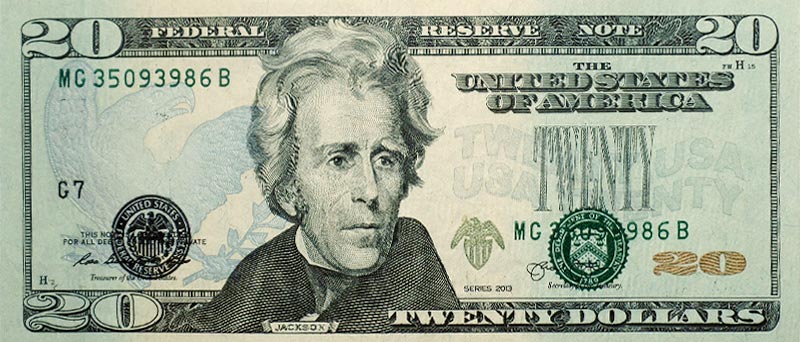
This $20.00 Federal Reserve Note is yet another example of something going horribly, horribly wrong at the Bureau of Engraving and Printing. This particular error, called "Seal Shift,"is similar to the "Seal Drop" described above and occurs when the the currency sheet moves during third printing when multiple elements are supposed to printed simultaneously (but are actually applied by different machines), causing some of the elements (in this case both seals and the district numbers) to be shifted down.
|
|
Series 1996 Twenty Dollar Federal Reserve Note [Fancy Serial Number]

Nothing rare or particularly unusual about this Series 1996 Twenty Dollar Federal Reserve Note, except for the fact that it has an unusual serial number of 10101010. This type of serial number is, I believe, referred to as a "true binary super repeater".
|
|
Series 1999 Twenty Dollar Federal Reserve Note [Fancy Serial Number]

Nothing rare or particularly unusual about this Series 1999 Twenty Dollar Federal Reserve Note, except for the fact that it has an unusual serial number of 80808080. This type of serial number is, I believe, referred to as a "binary repeater" or "super repeater".
|
|
One Dollar | Two Dollar | Five Dollar | Ten Dollar | Twenty Dollar | Fifty Dollar | Hundred Dollar | Miscellaneous
|